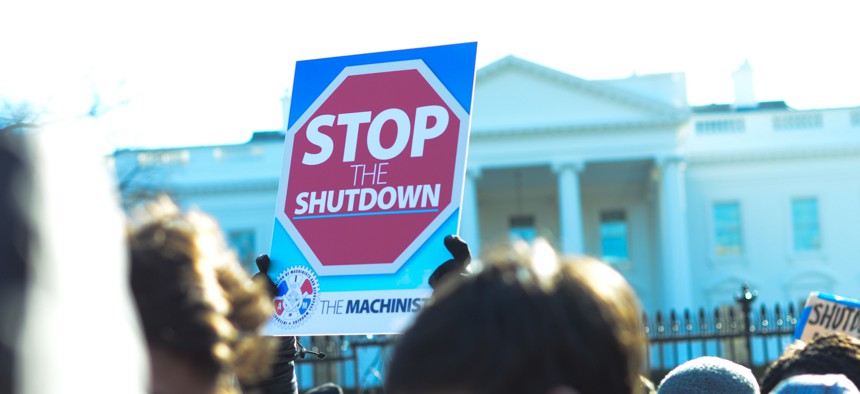
Federal employees and their allies rallied outside the White House on Jan. 10. AFGE
Who Are the Federal Workers Affected by the Shutdown? Five Questions Answered.
The current government shutdown is now the longest in American history, affecting about 800,000 federal employees.
The current government shutdown is now the longest in American history, affecting about 800,000 federal employees out of 1.8 million full-time civil servants, not counting military personnel and postal workers.
Of those, about 380,000 have been furloughed, meaning that they cannot work or get paid. The rest, whose positions are categorized as essential, are working without pay.
Here’s a closer look at some quick facts about the U.S. federal workers.
1. Who are they?
According to the U.S. Office of Personnel Management’s federal employee database, about 57 percent of federal workers were male and 43 percent were female in 2017. About 63 percent were white and 19 percent were black. Over half of the workforce had a college degree and about a quarter also had an advanced degree.
The federal civilian workforce has grown older than the American workforce overall. The average federal worker was 47.5 years old in 2017. Just about 16 percent of federal workers are under 35 years old, compared to 40 percent in the private sector. More than a quarter of federal employees are over 55.
2. Where do they work?
They might be your neighbors. More than 80 percent of the federal workers work or live outside of the Washington, D.C. metropolitan area.
According to Governing magazine’s calculations, nearly every state has a least a few thousand affected employees. OPM shows that California tops the list with 152,466 federal workers, followed by Virginia, Texas, Maryland and Florida.
More than 18 percent work for the Department of Veterans Affairs. In fact, almost 60 percent of the federal workforce is employed by just five agencies: the VA, Army, Navy, Homeland Security and Air Force.
3. How much do they make?
Under open government transparency guidelines, records of most public employees of the U.S. federal government is public record.
As of 2017, the average salary among 375 agencies was US$69,344.22. In fiscal year 2017, about a quarter of the federal workers made less than $56,143.
How does this compare to the average American worker? Researchers disagree over how to compare salaries between public and private sectors. Studies comparing federal employees to workers in other sectors arrived at different conclusions about the sector with the higher pay and the size of the pay disparities.
Salary varies considerably by position, agency and tenure. For example, in fiscal year 2017, the average salary for clerical workers was just shy of $42,000. According to the Bureau of Labor Statistics, their median tenure – number of years with their current employer – was 8.3 years, highest among government employees, and much higher than the 3.8 years for private sector employees.
4. What do they do?
Federal workers perform a variety of critical roles in service of the country, such as developing science and technology; protecting the waterways; certifying commercial aircrafts; screening passengers; ensuring food safety and inspection; investigating crime; and providing emergency care.
Federal workers are employed in over 300 different occupations, according to the U.S. Bureau of Labor Statistics. According to the latest available data by FederalPay.org, the most common federal occupation was nurse, followed by miscellaneous administration and program positions, and compliance inspectors.
5. What does this mean for the future?
Complaints about the size of the government and pledges to shrink the federal bureaucracy are not new. But public administration research shows that politicians exaggerate alleged governmental waste and misconceive the federal government as bloated, while ignoring the increasing role of private sector partners.
The size of the federal workforce has remained pretty flat since 1960s, increasing by about 8 percent from 1962 to 2012. Meanwhile, both the U.S. population and the congressionally mandated rules and regulations have more than doubled in size. Federal spending has grown exponentially during that time, due to entitlement spending – pensions, health care and welfare – and the increasing inclusion of nongovernmental actors via outsourcing and contracts.
In the face of looming retirements in the federal service, agencies are concerned about how to attract and retain the next generation of workers. Some of my research focuses on public service motivation – the desire to serve the public and the society, a trait that government workers possess at higher levels. Many forgo opportunities in private sector, because they care deeply about the mission of their agency and their role in serving the public.
In a 2015 study, I examined work motivations and turnover intentions of young workers in the U.S. federal agencies. While they are similar to their older counterparts in terms of their work motivations, they are much more likely to consider leaving their jobs. Problems in hiring and retention would most likely be exacerbated by the shutdown, as well ongoing issues such as weakening civil service protections; salary freezes or delay in appointments; and attacks on certain agencies.
![]()
![]()
This post originally appeared at The Conversation. Follow @ConversationUS on Twitter.






